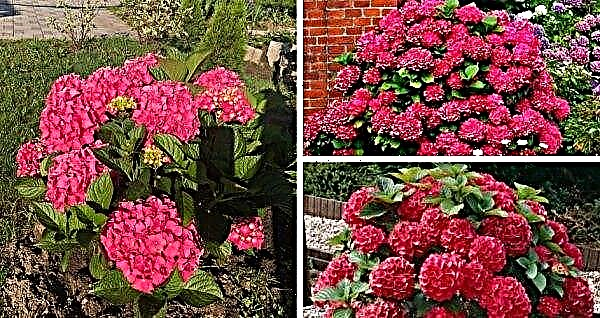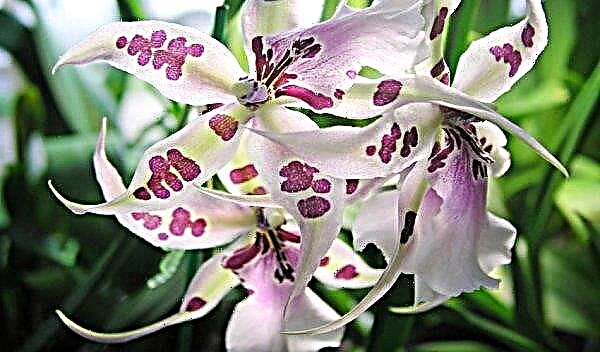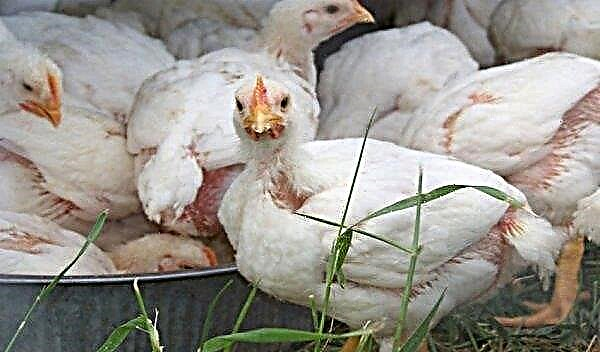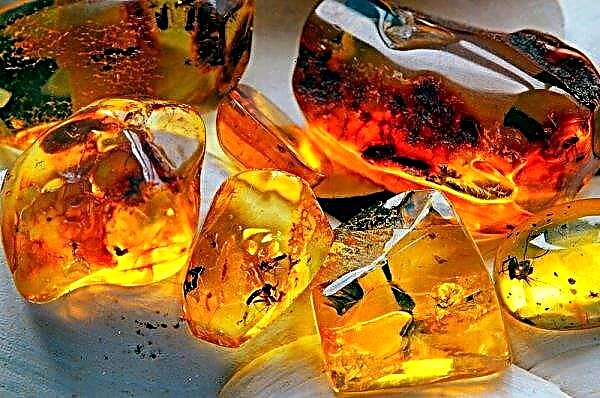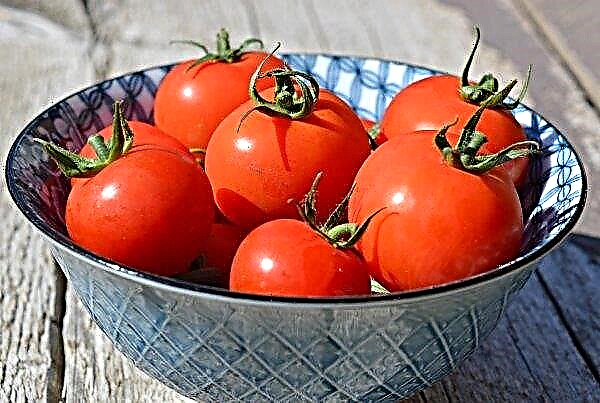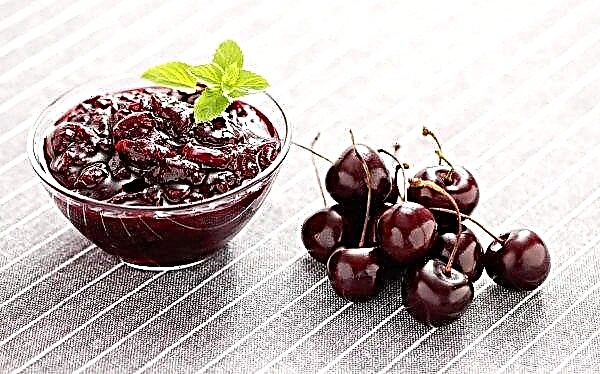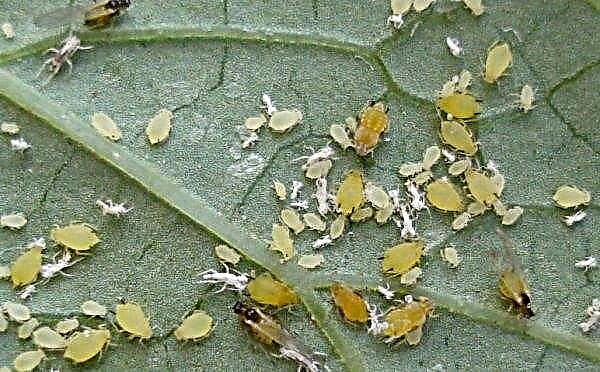If you want to grow in your garden plot not only a source of tasty and healthy berries, but also a real decoration of any garden, you should pay attention to lingonberries. This wild-growing shrub is difficult to tame, but if all the requirements for the conditions of its growth are met, this task is quite solvable.
Botanical Description
Lingonberry is an evergreen shrub of small stature (10–20 cm). It can reach these sizes if grown in a garden, but in a forest, when it is necessary to overcome obstacles in the form of dry branches, weeds, this plant can be much higher. Lingonberry in Latin means "vine from Mount Ida." There is a mountain on the island of Crete called Ida, apparently, it is somehow connected with this berry. This plant belongs to the genus Vaccinium family Heather. The leaves of the plant are obovate or elliptical on short petioles with curved edges. Above they are dark green, below - light green, shiny, leathery. The leaves are about 3 cm long and 1.5 cm wide.
This plant belongs to the genus Vaccinium family Heather. The leaves of the plant are obovate or elliptical on short petioles with curved edges. Above they are dark green, below - light green, shiny, leathery. The leaves are about 3 cm long and 1.5 cm wide.
Did you know? The lingonberry blooms last for only two weeks.
The rhizome is horizontal, creeping. From it branching shoots grow up to 20-25 cm in height. Lingonberry blooms in late spring - early summer, its flowers are incredibly beautiful, white-pink, bell-shaped, located on the tops of the branches with rare tassels. The fruits are bright red, in the shape of a ball, shiny, sweet and sour, have small seeds. The diameter of the berries is about 8 mm. They ripen from August to September.
Characteristics, features of culture
Cranberries are often confused with cranberries, but these berries have significant differences. They grow in different ways, because cranberries spread on the ground, and lingonberries look like a shrub that grows very slowly. In addition, cranberries have larger berries with a small bitterness, and the leaves are thinner; they look like needles. Lingonberry soil prefers acidic, dry, clayey, but cranberries, on the contrary, love moist, loose places for growing. The main feature of lingonberries is that its berries can be picked twice a season. Harvest time depends on weather conditions. The berry can be ready for use in August or already in October, when it is fully nourished by the sun, and will become very tasty and fragrant with shiny bright red sides. Lingonberry leaves also have one feature: they can retain moisture due to pinholes on the underside of the leaves.
The main feature of lingonberries is that its berries can be picked twice a season. Harvest time depends on weather conditions. The berry can be ready for use in August or already in October, when it is fully nourished by the sun, and will become very tasty and fragrant with shiny bright red sides. Lingonberry leaves also have one feature: they can retain moisture due to pinholes on the underside of the leaves.
Water from the upper side rolls down, where it is absorbed by these dimples. And you must not forget that lingonberries accumulate radiation in large quantities, so you need to collect it in clean, safe places and buy only in trusted markets from people you trust. And it’s best to grow it at home and then you can be sure of the quality of the berries.
Did you know?The lingonberry is not inferior even to oak in terms of life, because it can live for about 300 years.
Growing area
Lingonberry is a wild-growing plant that loves poor acidic soils; therefore, it grows on dried peat bogs, in the mountains of Siberia, the Caucasus, and the Far East. These beautiful shrubs in the wild are found in the Tundra, they love the forest, both coniferous and mixed. Recently, lingonberries are increasingly appearing in personal plots. Although it is difficult to create suitable growing conditions for her, she was very fond of gardeners because of her beauty and usefulness.
Recently, lingonberries are increasingly appearing in personal plots. Although it is difficult to create suitable growing conditions for her, she was very fond of gardeners because of her beauty and usefulness.
Decorative and useful properties
Due to the fact that lingonberry is an evergreen shrub, it looks very appropriate in the landscape of personal plots. It can be grown as a groundcover to create alpine slides and rockeries. In the landscaping of plots, lingonberry leaves, which do not turn yellow and do not fall with the advent of autumn, and incredibly beautiful flowers, and red beads of berries are also very much appreciated.
And also this plant is very useful, due to its composition, therefore it is widely used in folk medicine. The leaves contain arbutin - a natural antiseptic. They make tonic tea, which quickly relieves fatigue and helps to restore strength. Lingonberry berries are very useful to eat with hypovitaminosis, because they are a natural source of vitamins C, A, E, carotene.
Thanks to them, you can maintain immunity, fight anemia, which is especially important for children and pregnant women. Decoctions of berries help fight fever and perfectly quench your thirst. Lingonberry juice lowers blood pressure, soothes, improves intestinal motility. With colds, linden tea with lingonberry jam helps. And this jam is very useful for women in labor. In the treatment of diseases of a bacterial nature, lingonberry berries are simply irreplaceable, because they enhance the action of antibiotics and sulfonamides. And even flowering shoots are very useful, because they help with diseases of the female genital organs and contribute to the preservation of pregnancy. And from lingonberry berries prepare very tasty dishes and preservation. They make sauces, juices, fruit drinks and jams.
In the treatment of diseases of a bacterial nature, lingonberry berries are simply irreplaceable, because they enhance the action of antibiotics and sulfonamides. And even flowering shoots are very useful, because they help with diseases of the female genital organs and contribute to the preservation of pregnancy. And from lingonberry berries prepare very tasty dishes and preservation. They make sauces, juices, fruit drinks and jams.
Varieties and varieties
In order to determine which sort of lingonberry you want to see on the garden site, you need to know how they differ from each other. Today there are about two dozen of them.
It is worth considering the most popular of them:
- Coral - a variety of Dutch selection. Its bushes are up to 30 cm tall and as wide. This variety loves moist swampy soils, so you need to make sure that the soil under it does not dry out. If good care, then you can collect from 1 hundred parts to 60 kg of berries. The color of the fruit is bright red.
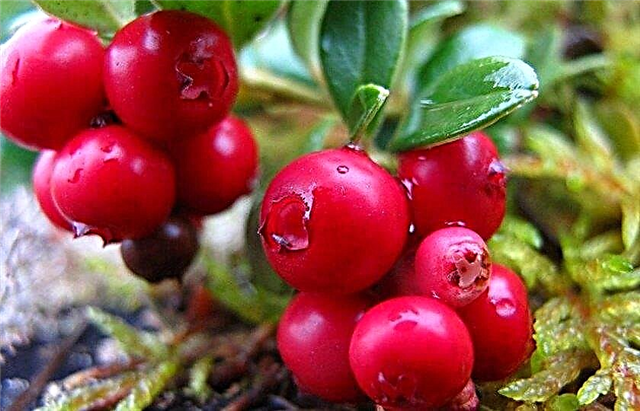
- Sanna - This variety comes from Switzerland. It is popular in landscape design. The height of the bush is 15-30 cm. In August it gives 300 g of berries from the bush. Their color is coral red.
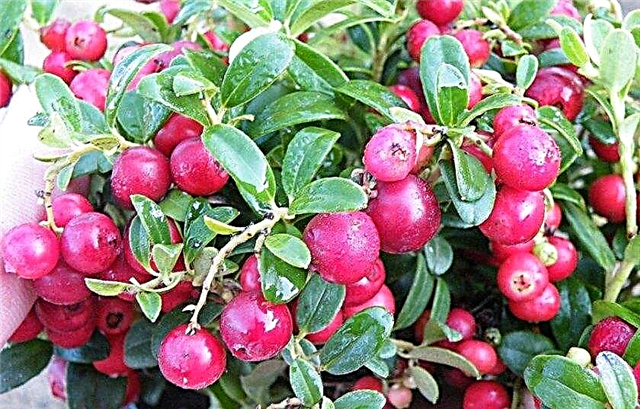
- Red pearl - An early Dutch variety. Bushes up to 30 cm tall, quite branched, voluminous, leaves are large, dark green. Berries are burgundy, ripen twice a season.
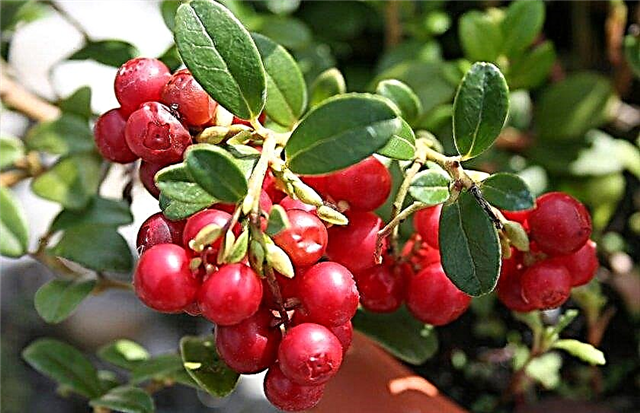
- Ruby - a variety with bushes about 30 cm. The leaves are elliptical, dark green, the fruits are bright red. The variety is very fond of sunlight.

- Ammerland - a plant with low bush-balls and emerald green leaves. The berries are light red. The fruits ripen twice a season. He likes well-lit places without tall trees nearby.
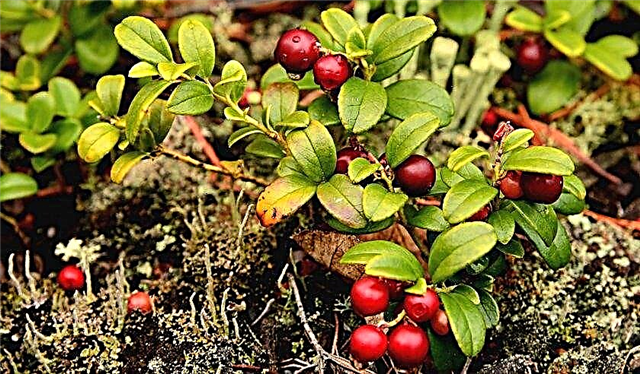
- Mazovia - Polish variety with small burgundy berries. Fruits in mid-autumn.

- Linnaeus - named after the Swedish breeder. Bushes up to 25 cm with a well-defined main stem. The fruits are scarlet, ripen in mid-autumn.

- Kostromichka- this variety bears fruit once a season, in August, the fruits are sweetish-sour taste, dark red, 7-8 mm in diameter.

Landing rules
Given the fact that lingonberries love to grow in the forest on acidic soils, you need to work hard to make her feel good at home in your garden. But this is quite possible if you fulfill a number of conditions necessary for the proper cultivation of this plant.
The timing
Lingonberry bushes can be planted in spring and autumn, since it is an evergreen shrub, planting dates do not greatly affect its survival in a new place. It is better to plant early in the morning or in the evening.
Site selection, soil preparation and wells
Lingonberry bushes love the soil, as close as possible to the one to which they are accustomed to in natural conditions. Therefore, for their cultivation, it is necessary to prepare the soil. The place you need to choose is well-lit, with acidic dry soil (PH 3.5-5.5). The surface should be flat enough so that it is not flooded by rains and water does not stagnate. Also a very important characteristic is the friability of the soil, because with a lack of oxygen, the rhizome can die, which will lead to the death of the bush.
If the land on your site does not have the necessary characteristics for comfortable growth and development of lingonberries, it can be artificially acidified. To do this, add sawdust, peat, sand and needles in equal proportions to it and dig it all up. Lingonberry does not tolerate the proximity of groundwater to its roots, so the water should be at least 50 cm deep. But if the groundwater is too deep, the soil can dry out very much, which is also not very good for plants.
Selection and preparation of planting material
For planting, it is best to use 2-3 year old seedlings. They must be strong, healthy, with a well-developed root system. They cannot have damage and signs of disease. It’s better to choose seedlings of varieties that you like best, because they practically do not differ in properties.
Important! You can water the bed with acidified water for an even better effect. To do this, dilute 100 g of citric acid in 3 l of water.
Step-by-step landing technology
If you have already chosen a place for planting and prepared the soil, then you must perform the following steps:
- Mark the territory intended for planting bushes so that the plants are in a row not less than 30 cm apart, and the distance between the rows should also be about 30 cm.
- Dig holes 6-8 cm deep.
- Insert the plant into the hole so that the root is free, straighten the rhizome and sprinkle with soil.
- Pour the plant with settled water, or clean water from a well if it does not contain chlorine.
- Mulch the soil around the bush with needles, sawdust, sand, shredded bark.
- The first ten days after planting, cranberries need to be watered in order to better root, and then look according to the circumstances.
Combinations with other cultures
Lingonberries are now very actively used in landscape design, because its undersized, almost creeping on the ground, evergreen bushes look very impressive on alpine slides. Especially when they bloom with white or pale pink bells, or are strewn with bright red beads of berries. Dark junipers and other conifers look great next to bright lingonberries.
In addition, lingonberries get along very well with them both in the wild and in the garden. But near tall trees with large rhizomes and branches, cranberries are not recommended to be grown, because it does not tolerate shaded areas, and besides this neighborhood, it suffers from a lack of moisture.
How to grow from seed to seedlings at home
Russian breeders bred three varieties of lingonberries, which can be grown from seeds in our conditions. But, if when growing seedlings, you can get the crop already in the second year, then from the seeds full-fledged plants that give the crop will be only after 4 years.
Growing lingonberry bushes from seeds consists of the following stages:
- Seed stratification at 4 ° C.
- Seed is sown in soil from three parts of peat and two parts of sand.
- Air temperature should be at least 20 ° C, soil acidity - 3-4.5 PH.
- Within a month there will be shoots.
- When the seedlings have 4-5 leaves, they can be transplanted into the greenhouse, in which they will be for about a year.
- For the winter, seedlings must be covered with a spanbond and mulched.
- In spring, young shoots are planted in a specially designated place for them at a distance of 25 cm from each other.
- Seedlings are planted in a permanent place at the age of two.
- Young plants are fed with mineral fertilizers: ammonium and potassium sulfate, as well as superphosphate.

Care Rules
Lingonberry bushes are not very picky in care. If they prepared the right ground for them to take root, the most important measures have already been taken.
Important!In no case should you feed lingonberries with fertilizers containing chlorine, they are fatal to it.
But in order for the plant to feel comfortable, develop well and give a stable crop, you need to properly care for it:
- Water the bushes with drip irrigation or irrigate no more than twice a week. Lingonberry does not like high humidity, but also does not tolerate drought, so you need to water it on time and in moderation.
- Acidify the soil once a month, as water can leach acid over time.
- Weed weeds so that they do not interfere with the plant's development.
- Mulch the soil around the bushes with peat, sand or needles.
- In the early spring before the start of sap flow or in the fall after harvest, in the seventh year of growing growth, it is necessary to begin anti-aging pruning. To do this, it must be shortened by half or a third.
- Lingonberry mineral fertilizers are practically unnecessary, because its rhizome is braided with mycelium of the mycorrhiza fungus, through which it receives all the minerals in the soil. Sometimes you can slightly feed the plants, but rarely and on time. For example, in the first two years of growth, nitrogen fertilizers can be added, and in the fifth year, a complex mixture.

Flowering and fruiting
Depending on the variety, lingonberry blooms in April-May, and begins to bear fruit from July to September-October. The beauty of the flowers of this plant is beyond description. They are white, or slightly pinkish, similar to bells. The fruits of all shades of red, from bright scarlet to burgundy, rounded, medium size.
Harvesting and storage
Depending on the variety, lingonberries ripen in July-August, and then it can be harvested. When picking berries, it is very convenient to use a special scoop that does not crush the berries and very carefully picks them from the branches. Only you need to do this carefully so as not to damage the delicate shoots. Lingonberries can be stored fresh long enough without losing their qualities. This is all thanks to benzoic acid, which is part of it.
The most useful way to store lingonberries is by soaking the berries in water. To do this, the berries are carefully sorted out from the garbage, washed and poured with boiling water. Thanks to benzoic acid, they can be stored this way for a very long time, and no preservatives are needed. Also, this berry produces excellent jams, sauces, fruit drinks, and you can just grate it with sugar and store in the refrigerator. Lingonberry leaves are no less valuable than the fruits. They need to be collected in spring or autumn, since the leaves collected in the summer turn black and deteriorate. Dry the raw materials in a dark, dry place. If the leaves are collected in time and properly dried, they will be green with brown dots on the underside. Store leaves in glass jars or in canvas bags for 3-4 years.
Lingonberry leaves are no less valuable than the fruits. They need to be collected in spring or autumn, since the leaves collected in the summer turn black and deteriorate. Dry the raw materials in a dark, dry place. If the leaves are collected in time and properly dried, they will be green with brown dots on the underside. Store leaves in glass jars or in canvas bags for 3-4 years.
Winter preparations
Lingonberry, in principle, tolerates winter well. To protect it from too severe frosts, it is recommended to cover the bushes with a spanbond for the winter. And also this plant is afraid of frost in early spring, so the first time, while the weather is not stable, it is advisable to cover it for the night. In the morning, you need to open it so that the plant receives enough sunlight.
Breeding methods
Lingonberry propagates in three ways: by replanting bushes, cuttings and seeds. Cuttings can be harvested during anti-aging pruning of bushes. They should be no more than 5 cm. Cuttings sit in the ground for two weeks and are covered with a film, or in a greenhouse. After 2 weeks, they are transferred to a place for seedlings and grow there, gaining strength. In a year or two, when the seedlings get stronger, they can be transplanted to a permanent place. To care for them is the same as for the bushes. You can propagate cranberries and seeds, but in this case, the harvest will be only after 4 years. And you need to remember that lingonberry sprouts only in the light.
In a year or two, when the seedlings get stronger, they can be transplanted to a permanent place. To care for them is the same as for the bushes. You can propagate cranberries and seeds, but in this case, the harvest will be only after 4 years. And you need to remember that lingonberry sprouts only in the light.
Diseases and pests: control and prevention
Lingonberries are quite resistant to diseases, but still sometimes affected by exobazidiosis, sclerotinia and moniliosis. Sclerotinia leads to mummification of berries, due to exobazidiosis shoots grow and whiten strongly, and monolioz completely dries out the plants, because of which they die.All these are fungal diseases, and the best way to combat them is to treat the plants with Bordeaux fluid. The main pests of lingonberries are leafworms. You need to spray the solution with bushes three times at intervals of 2-3 weeks. To prevent such diseases, it is necessary to pay due attention to weeding shrubs from thickets and not to allow swamping of the site. They gnaw young leaves, flowers, and the ovary, but rarely cause significant damage to the crop, due to the fact that they appear only in isolated cases, and they can hardly be considered a serious problem.
The main pests of lingonberries are leafworms. You need to spray the solution with bushes three times at intervals of 2-3 weeks. To prevent such diseases, it is necessary to pay due attention to weeding shrubs from thickets and not to allow swamping of the site. They gnaw young leaves, flowers, and the ovary, but rarely cause significant damage to the crop, due to the fact that they appear only in isolated cases, and they can hardly be considered a serious problem.
Industrial Growth
Lingonberries have been cultivated on an industrial scale for a long time in Sweden and Finland, there are also separate plantations in Germany and the USA, but we still have very poor industrial production of this useful berry.
For industrial cultivation, the following varieties are most suitable:
- dutch - Coral and Red Pearl;
- German - Ammerland, Erntekrene, Erntezegen;
- polish - Mazovia, Fleece Belyaevskoe;
- swedish and finnish - Linnaeus, Ida, Sanna;
- Kostromichka, Kostroma Pink, Ruby.
Lingonberry in the Tundra
The tundra is one of the native places of growth for lingonberries. Unlike forest species, in the Tundra, bushes grow no more than 7 cm. The bright red berries of lingonberries, which often ripen twice a season, enjoy the animals and birds that live in this area with pleasure. They attract forest inhabitants with their coloring.
The bright red berries of lingonberries, which often ripen twice a season, enjoy the animals and birds that live in this area with pleasure. They attract forest inhabitants with their coloring.
Lingonberry in the suburbs: cultivation and care
Lingonberries grown in the Moscow Region are characterized by the fact that it bears fruit from August to September, which is very important, because at that time all the other berries already cease to give birth, therefore this source of vitamins is very important. Varieties specially developed for Russia and its severe weather conditions are ideally suited for the Moscow Region.
This is Ruby and Kostromichka. Coral variety also grows and bears fruit well in this area. Due to its unique features, lingonberries are becoming more and more popular in our time. Its green leaves, which do not turn yellow and do not dry during the year, will decorate any garden.
And not only leaves, but also very beautiful flowers and juicy bright berries. And the amount of useful properties of this plant does not lend itself to any description at all. If you want to grow this incredibly healthy and tasty berry in your garden, you just need to create suitable conditions for it, and it will surely please you with a stable crop.









